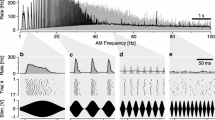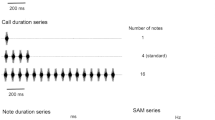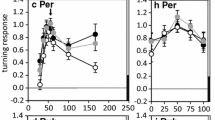Abstract
Previous experiments demonstrated that in choice situations female Tettigonia cantans prefer signals with the conspecific spectrum over signals with the spectrum of the sibling species T. viridissima, whose signals lack the T. cantans-typical 8-kHz component but are otherwise identical in spectral composition. The underlying neuronal mechanisms were investigated using whole-nerve recordings of the tympanal nerve. Hearing thresholds did not differ significantly between the species in the range between 7 and 25 kHz. The responses of the tympanic nerve at 30 dB above threshold did, however, differ significantly between the species. While in T. viridissima response amplitudes did not differ between 7 and 12 kHz, in T. cantans responses at 8 kHz were significantly larger than at 10 and 12 kHz. Since possible influences of axonal diameters on response magnitudes were excluded, these results indicate that in T. cantans more receptor cells are tuned to 8 kHz than to 10–12 kHz, while in T. viridissima tuning of receptor cells is more evenly distributed. The higher response magnitude in T. cantans at 8 kHz than at 10–12 kHz is equivalent to an amplitude difference of 3.8–7 dB, which agrees well with previous behavioural estimates.
Similar content being viewed by others
Author information
Authors and Affiliations
Additional information
Accepted: 13 January 1999
Rights and permissions
About this article
Cite this article
Schul, J. Neuronal basis for spectral song discrimination in the bushcricket Tettigonia cantans. J Comp Physiol A 184, 457–461 (1999). https://doi.org/10.1007/s003590050345
Issue Date:
DOI: https://doi.org/10.1007/s003590050345




